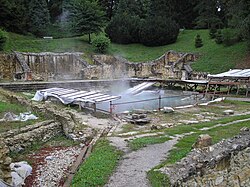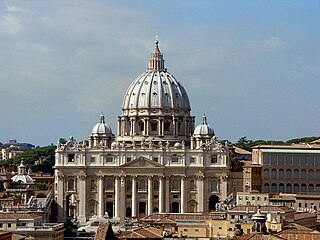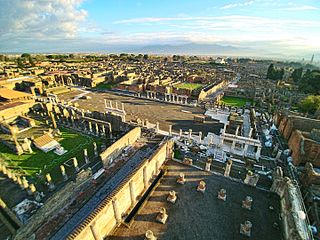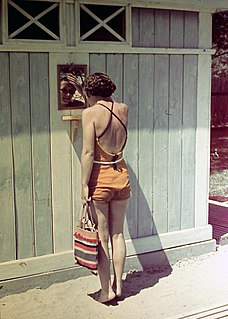
A spa town is a resort town based on a mineral spa. Patrons visit spas to "take the waters" for their purported health benefits. The word spa is derived from the name of Spa, a town in Belgium.

Aquae Sulis was a small town in the Roman province of Britannia. Today it is the English city of Bath, Somerset.

The Roman Baths complex is a site of historical interest in the English city of Bath. It is a well-preserved Roman site once used for public bathing.

In localised Celtic polytheism practised in Great Britain, Sulis was a deity worshipped at the thermal spring of Bath. She was worshipped by the Romano-British as Sulis Minerva, whose votive objects and inscribed lead tablets suggest that she was conceived of both as a nourishing, life-giving mother goddess, and as an effective agent of curses wished by her votaries.
A spa is a location where mineral-rich spring water is used to give medicinal baths. Spa towns or spa resorts typically offer various health treatments, which are also known as balneotherapy. The belief in the curative powers of mineral waters goes back to prehistoric times. Such practices have been popular worldwide, but are especially widespread in Europe and Japan. Day spas are also quite popular, and offer various personal care treatments.

Laško is a spa town in eastern Slovenia. It is the seat of the Municipality of Laško. Traditionally the area was part of the Styria region. The municipality is now included in the Savinja Statistical Region. The town is located at the foothills of Hum Hill on the Savinja River. It was first mentioned in written documents dating to 1227 and was granted town privileges in 1927. It is known to have been settled since the Iron Age and Roman archaeological finds are common in the area, though the precise location of the Roman settlement is not known. Today the town is best known for its annual Festival of Beer & Flowers and the local Laško Brewery, the largest brewery in the country. In 2010, Laško was heavily affected by flooding. The town's coat of arms depicts three white fleurs-de-lis on a blue field.

Dolenjske Toplice is a settlement near Novo Mesto in southeastern Slovenia and is the seat of the Municipality of Dolenjske Toplice. The area is part of the traditional region of Lower Carniola. The municipality is now included in the Southeast Slovenia Statistical Region. The town lies on the Sušica River, which joins the Krka 2 km north of town. It is a spa town known for its thermal baths established in 1658 by the Counts of Auersperg.

Lovas is a village and seat of municipality in the Vukovar-Syrmia County of eastern Croatia, located on the slopes of Fruška Gora, a few kilometers south of the main road connecting Vukovar with Ilok. Lovas has a population of 1,214 (2011), and its municipality also includes the smaller village of Opatovac which is located to the north, at the Danube. Lovas is underdeveloped municipality which is statistically classified as the First Category Area of Special State Concern by the Government of Croatia.

Municipium Iasorum or Res publica Iasorum was an autonomous territory in ancient Roman Pannonia, located in the area around present-day town of Daruvar. Its administrative center was the town of Municipium Iasorum, located in or near present-day Daruvar. The territory of the region extended from the Sava to the Drava.

Stubičke Toplice is a municipality in Croatia in the Krapina-Zagorje County. With its centuries-old tourist tradition, it is a very popular vacation spot located in the continental part of the country, serving as a spa center and health resort. Connected by the state road D307 and L202 railway it is located 40 kilometers north from the country's capitol city Zagreb. From conformation of a local community, Municipality of Stubičke Toplice was founded on 27 April 1993 as a unit of local government.

Burnum, an archaeological site, was a Roman Legion camp and town. It is located 2.5 km north of Kistanje, in inland Dalmatia, Croatia. The remains include a praetorium, the foundations of several rooms, the amphitheatre and the aqueduct.
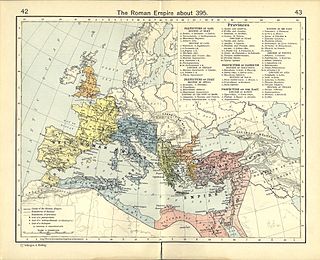
Stridon was a town in the Roman province of Dalmatia. The town is known as the birthplace of Saint Jerome. From Stridon also came the priest Lupicinus of Stridon. Although Domnus of Pannonia, a bishop who took part in the First Council of Nicaea, is often said to have hailed from or been bishop of Stridon, he was in fact bishop of Sirmium. In 379 the town was destroyed by the Goths. Jerome wrote about it in his work De viris illustribus: "Hieronymus patre Eusebio natus, oppido Stridonis, quod a Gothis eversum, Dalmatiae quondam Pannoniaeque confinium fuit...".

Rimske Toplice is a settlement in the Municipality of Laško in eastern Slovenia. It lies on the right bank of the Savinja River on the road from Celje to Ljubljana via Zidani Most. The area was traditionally part of the Styria region. It is now included with the rest of the municipality in the Savinja Statistical Region.
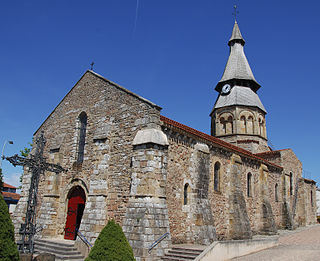
Néris-les-Bains is a commune in the Allier department in the Auvergne region in central France.

Mirko Malez was a prominent Croatian palaeontologist, speleologist, geo-scientist, ecologist and natural history writer. He was known as a "pioneer of Croatian speleoarchaeology". He was a member of the Yugoslav Academy, JAZU (present-day Croatian, HAZU - Croatian Academy of Sciences and Arts and one of only four Croatian PhDs of speleology. Thanks to Malez's popularization of science, Varaždin County, in northern Croatia, is also known as a "cradle of the Palaeolithic age".

The Archaeological Museum in Zagreb, Croatia is an archaeological museum with over 450,000 varied artifacts and monuments, gathered from various sources but mostly from Croatia and in particular from the surroundings of Zagreb.
Zdenko Vinski was a notable Croatian archaeologist.
Ivan Krstitelj Tkalčić was a noted Croatian historian and a Catholic priest and prebendary.

Aquae Calidae, also known as Therma and Thermopolis in the Middle Ages, was an ancient town in Thrace located in the territory of today's Bulgarian port city of Burgas. It was built around thermal baths using the hot springs and became one of the most important spa centres of ancient times.
